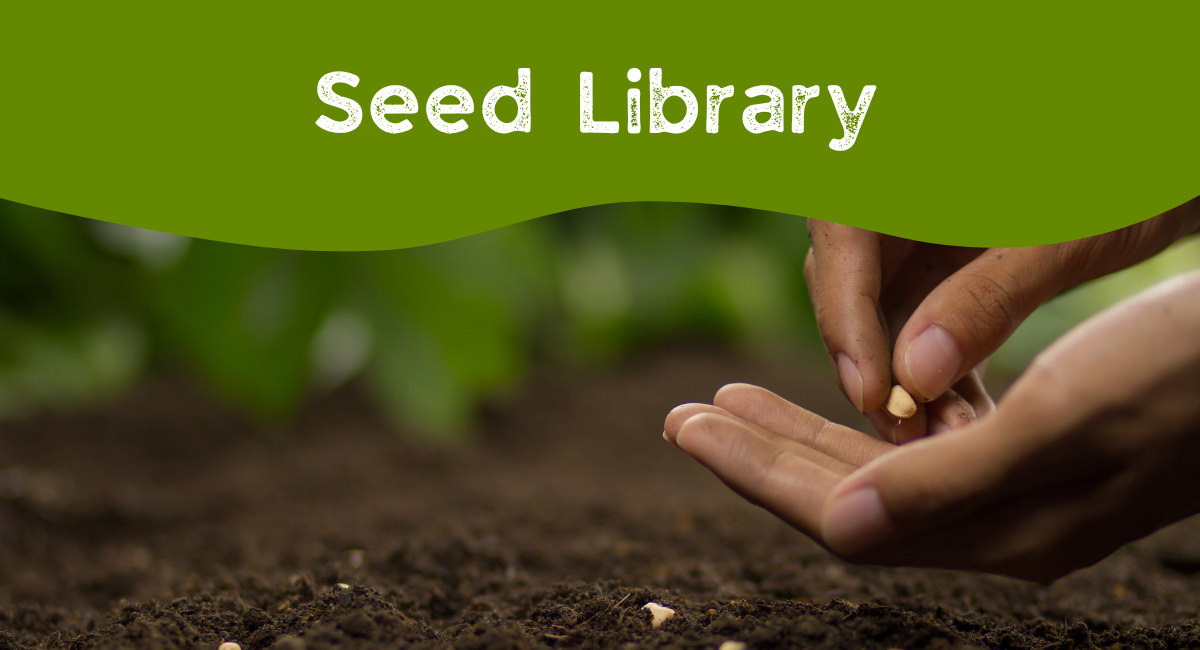
What is a Seed Library?
A Seed Library is a self-perpetuating collection of seeds donated and shared by members of our community. Hosted at all library branches, seeds are available free of charge to any library patron. You don't need a library card to use the seed library, but we'll be happy to make one for you.
The idea is simple: you borrow from a selection of vegetable and flower seeds at any time during the year, plant them in your garden, and watch them grow. When it’s time to harvest, let a plant or two go to seed, and bring some of the seeds back to the library for other gardeners to enjoy.
Seed Starting Tips
- Know your seeds - some should be started indoors 6 – 8 weeks before planting outside (peppers), some should be directly sown outside (beans).
- Before planting your seeds, pre-soak in a damp paper towel for 24 hours.
- Pre-moisten soil and plant the seeds in containers that allow for air flow and drainage.
- Plant the seed at a depth approximately 3 times the length of the seed. Label each container to keep track of which plants are which.
- Once planted, keep seeds warm and humid to encourage germination, between 19 – 24 degrees Celsius. To do this, cover with a clear lid or plastic wrap. Remember that seeds don’t need a lot of light until they have sprouted.
- Once your seeds have sprouted, keep them in a sunny place. You may want to consider using a grow light.
- Remove the lid or covering once seeds have sprouted. Keep soil moist and fertilize weekly.
- Check for overcrowding. If you have planted multiple seeds in the same pot, pull weaker/smaller sprouts to give the larger/stronger sprouts room to grow.
- ‘Pot up’ if necessary – if your seedling is outgrowing its container before it is time to plant outside, you may want to pot it up into a slightly larger container.
- ‘Harden off’ your plant - up to a week before you plant outside, let your seedlings sit outside in a sunny spot for a few hours each day so it gets used to outside conditions.
- Plant outside after the threat of frost has passed, usually after Victoria Day weekend.
Seed Saving Tips
- Seeds must be fully dry before storage to prevent the seeds from breaking down and failing to germinate the following year.
- Store seeds in a dark, cool, and dry place like the back of the fridge over winter in envelopes. A special tip is to place a silica packet with them to absorb any moisture.
- You can save seeds from heirloom or non-hybrid plants. It is not recommended to save seeds from hybrids or GMOs. Hybrid sees may result in weak and unhealthy plants due to their mixed parentage.
- Label the seed packets preferably in paper envelopes with the plant's name, season harvested, best growing conditions, and any other relevant information available.
- For guides on saving seeds, visit Southern Ontario Seed Saver or explore the large selection of gardening guides and books in the library's catalogue.
Download a Seed Library brochure.
- We are accepting donations at any time throughout the year.
- Community members can donate seeds by picking up labelled envelopes and information sheets from any GPL branch.
- At home, fill the envelope with 9 to 15 seeds, and fill out the information on the front of the envelope.
- Return the envelope to any GPL branch.
- Donated seed packets will be sorted and distributed to each branch.
- Each branch will have a chest of drawers that will house available seeds.
- Community members can go to any branch, and ask to pick up seeds.
- Growing and saving seeds from locally grown plants helps cultivate varieties that do well in our region.
- It helps preserve genetic diversity of old varieties.
- We hope to cultivate a network of seed savers in the region, supporting each other and the seed library as a resource for the gardening community.
- It helps to strengthen our local food system.
- Heirloom varieties provide different flavor profiles and interesting physical features, such as colorful carrots.
- Seeds are donated by community organizations and by people like you.
- Collecting local heirloom varieties helps preserve seed that might otherwise be lost.
- It promotes local agriculture by growing collections of seeds locally adapted to the region.
- Local experts host how-to classes, from planting seeds, companion planting, and saving seeds to preserving your bounty.
Contact
General Contact
Library Programs
90 Wexford Drive
Keswick, Ontario
L4P 3P7
Phone: 905-476-5762
Fax: 905-476-8724
libraryprograms@georgina.ca










